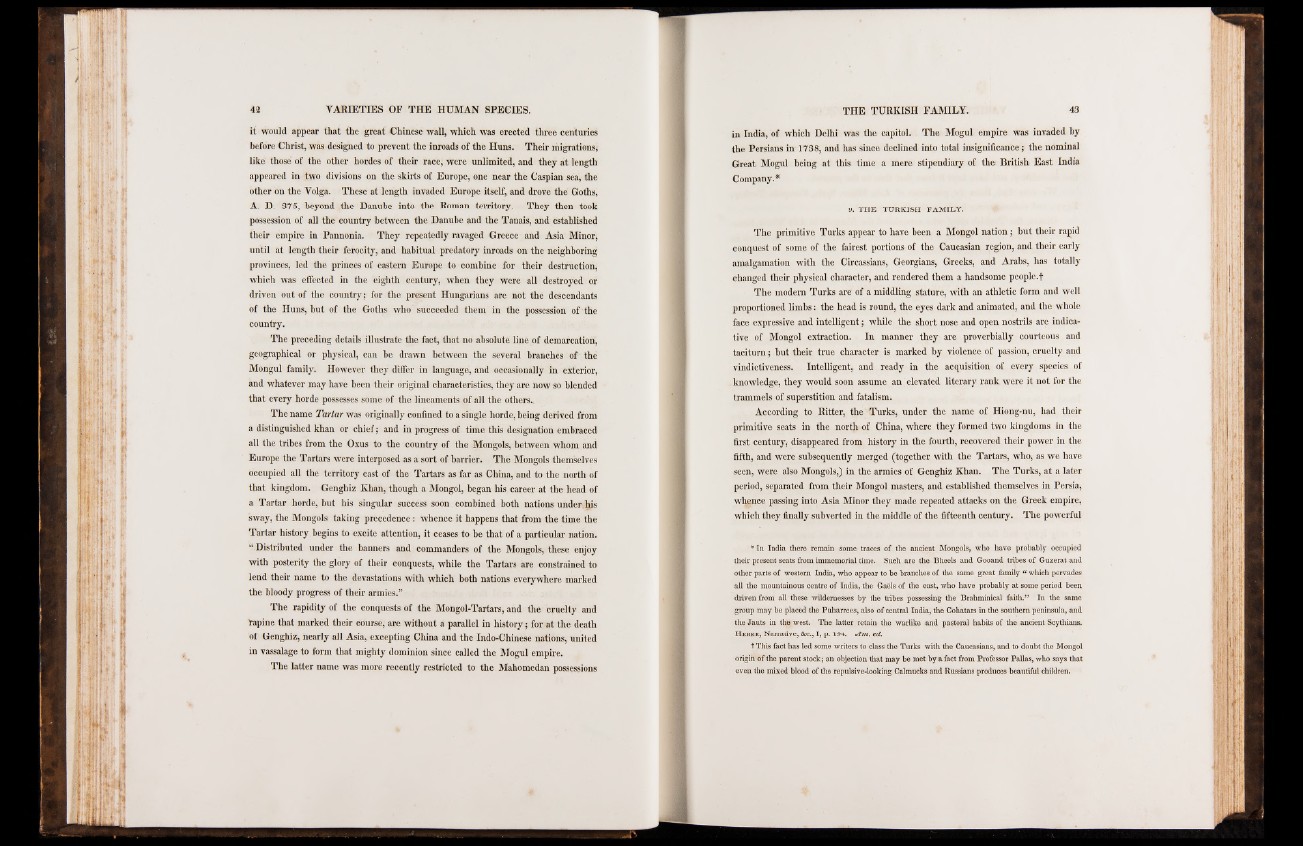
it would appear that the great Chinese wall, which was erected three centuries
before Christ, was designed to prevent the inroads of the Huns. Their migrations*
like those of the other hordes of their race, were unlimited, and they at length
appeared in two divisions on the skirts of Europe, one near the Caspian sea, the
other on the Volga. These at length invaded Europe itself, and drove the Goths,
A. D. 375, beyond the Danube into the Roman territory. They then took
possession of all the country between the Danube and the Tanais, and established
their empire in Pannonia. They repeatedly ravaged Greece and Asia Minor,
until at length their ferocity, and habitual predatory inroads on the neighboring
provinces, led the princes of eastern Europe to combine for their destruction,
which was effected in the eighth century, when they were all destroyed or
driven out of the country; for the present Hungarians are not the descendants
of the Huns, hut of the Goths who succeeded them in the possession of the
country.
The preceding details illustrate the fact, that no absolute line of demarcation,
geographical or physical, can he drawn between the several branches of thé
Mongul family. However they differ in language, and occasionally in exterior,
and whatever may have been their original characteristics, they are now so blended
that every horde possesses some of the lineaments of all the others..
The name Tartar was originally confined to a single horde, being derived from
a distinguished khan or chief; and in progress of time this designation embraced
all the tribes from the Oxus to the country of the Mongols, between whom and
Europe the Tartars were interposed as a sort of harrier. The Mongols themselves
occupied all the territory east of the Tartars as far as China, and to the north of
that kingdom. Genghiz Khan, though a Mongol, began his career at the head of
a Tartar horde, hut his singular success soon combined both nations under his
sway, the Mongols taking precedence: whence it happens that from the time the
Tartar history begins to excite attention, it ceases to he that of a particular nation.
“ Distributed under the banners and commanders of the Mongols, these enjoy
with posterity the glory of their conquests, while the Tartars are constrained to
lend their name to the devastations with which both nations everywhere marked
the bloody progress of their armies.”
The rapidity of the conquests of the Mongol-Tartars, and the cruelty and
Yapine that marked their course, are without a parallel in history; for at the death
of Genghiz, nearly all Asia, excepting China and the Indo-Chinese nations, united
in vassalage to form that mighty dominion since called the Mogul empire.
The latter name was more recently restricted to the Mahomedan possessions
in India, of which Delhi was the capitol. The Mogul empire was invaded by
the Persians in 1738, and has since declined into total insignificance; the nominal
Great Mogul being at this time a mere stipendiary of the British East India
Company.*
9. TH E TURKISH FAMILY.
The primitive Turks appear to have been a Mongol nation; but their rapid
conquest of some of the fairest portion» of the Caucasian region, and their early
amalgamation with the Circassians, Georgians, Greeks, and Arabs, has totally
changed their physical character, and rendered them a handsome people.f
The modern Turks are of a middling stature, with an athletic form and well
proportioned limbs: the head is round, the eyes dark and animated, and the whole
face expressive and intelligent; while the short nose and open nostrils are indicative
of Mongol extraction. In manner they are proverbially courteous and
taciturn; hut their true character is marked by violence of passion, cruelty and
vindictiveness. Intelligent, and ready in the acquisition of every species of
knowledge, they would soon assume an elevated literary rank were it not for the
trammels of superstition and fatalism.
According to Ritter, the Turks, under the name of Hiong-nu, had their
primitive seats in the north of China, where they formed two kingdoms in the
first century, disappeared from history in the fourth, recovered their power in the
fifth, and were subsequently merged (together with the Tartars, who, as we have
seen, were also Mongols,) in the armies of Genghiz Khan. The Turks, at a later
period, separated from their Mongol masters, and established themselves in Persia,
whence passing into Asia Minor they made repeated attacks on the Greek empire,
which they finally subverted in the middle of the fifteenth century. The powerful
* In India there remain some traces of the ancient Mongols, who have probably occupied
their present seats from immemorial time. Such are the Bheels and Gooand tribes of Guzerat and
other parts of western India, who appear to be branches of the same great family “ which pervades
all the mountainous centre of India, the Gaels o f the east, who have probably at some period been
driven from all these wildernesses by the tribes possessing the Brahminical faith.” In the same
group may be placed the Puharrees, also of central India, the Cohatars in the southern peninsula, and
the Jauts in the west. The latter retain the warlike and pastoral habits of the ancient Scythians.
Heber, Narrative, &c., I, p. 194. Am . ed.
t This fact has led some writers to class the Turks with the Caucasians, and to doubt the Mongol
origin of the parent stock; an objection that may be met by a fact from Professor Pallas, who says that
even the mixed blood of the repulsive-looking Calmucks and Russians produces beautiful children.